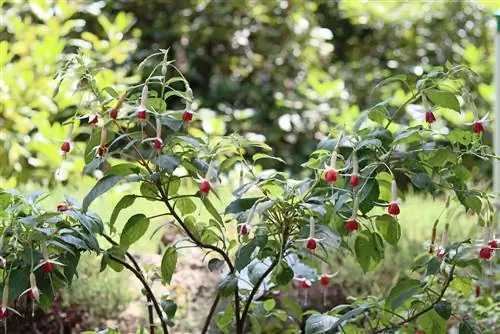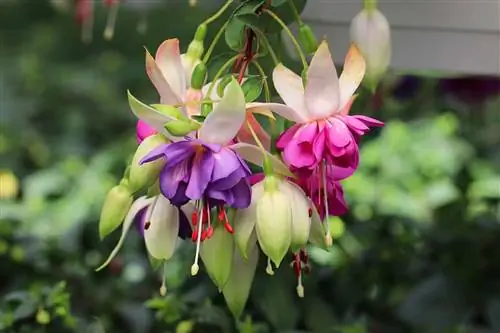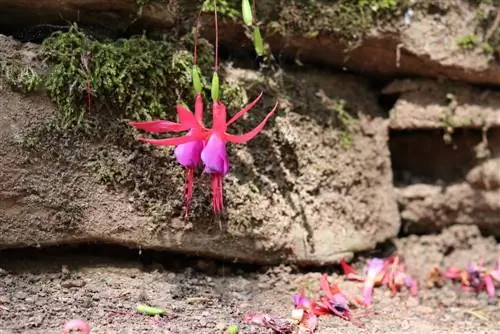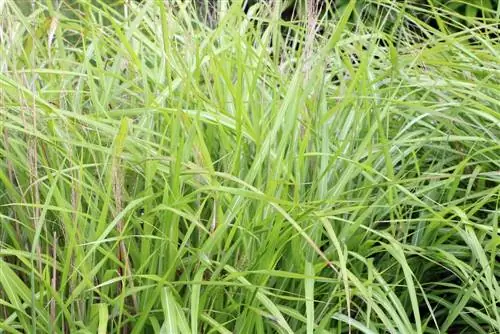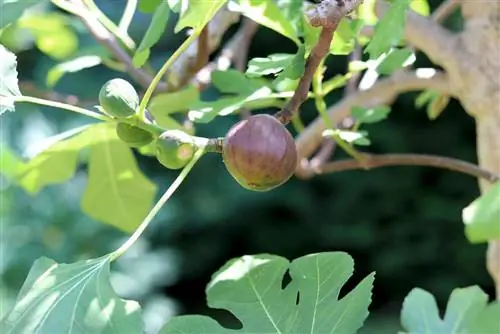- Author admin [email protected].
- Public 2023-12-17 03:39.
- Last modified 2025-01-24 12:45.
Originally shaped flowers in numerous color combinations make fuchsias one of the most popular plants for the pot. From June to November, many of these flowers hang down on delicate stems. Hardly any other plant is so flowery. It's good that there are also winter-hardy varieties that can stay outdoors all year round. But what requirements do these flowering wonders have?
Origin
The mountain forests in the impressive Andes of South America are the home of fuchsias. Most of the approximately 7,000 varieties are adapted to the mild climate that prevails there and therefore do not want to spend the cold days outdoors in Northern Europe. However, some varieties that grow at higher altitudes in the Andes are particularly resistant and robust. They can also withstand sub-zero temperatures and the winter-hardy varieties come from them.
The Fuchsia magellanica (also Magellan fuchsia or scarlet fuchsia) and the Fuchsia corallina can form new shoots directly from the root area in spring. Both trees grow into compact bushes up to 80 cm high. The strong red flowers stand out against the background of dark green leaves.
Winter-hardy varieties
More and more varieties are taking the climatic conditions of Northern Europe into account and are correspondingly hardy. Various new color variants have also developed from the original red varieties, including multicolored ones. The “mother” of the hardy specimens named below is the scarlet fuchsia.
- 'Riccartonii' with impressive color brilliance and long flowering period
- ‘Tricolor’ with white, green and pink colored leaves
- ‘Verysweet’ with two-tone flowers
- 'Whiteknight Pearl' with bass pink flowers that appear white from a distance.
Many other varieties are available commercially that can certainly trigger a passion for collecting. Because a true fuchsia lover cannot possibly choose just one plant and be satisfied with that.
Growth pattern
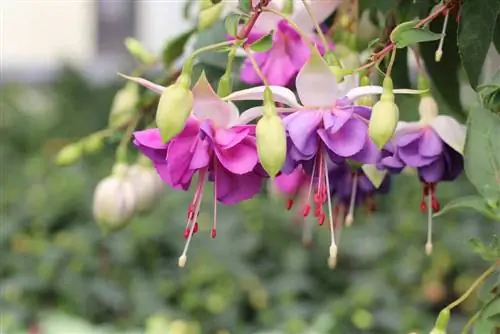
Hanging, semi-hanging and upright varieties give a lot of flexibility when planting. Whether for climbing, flower beds or as a climbing plant, there is a suitable variety for every garden area. Stems with a beautifully shaped crown are a beautiful eye-catcher in the pot. The different cultivars also differ considerably in their height. Short-growing varieties are only around 30 cm high.
Medium-growing varieties can grow up to 1 meter. Finally, there are varieties that can grow to be more than two meters tall. Height is a crucial criterion for choosing a suitable place. Or vice versa: The actual space available sets certain limits when selecting varieties.
Flowering time
The flowering period of fuchsias is long, very long. It starts in June and can last until the first night frosts. Flowers in December are still part of the repertoire. Fuchsias that bloom late are a rare and valuable treat for the many insects in the garden, such as bumblebees and bees. The small-flowered varieties are particularly often attacked by insects. Single-flowering varieties begin flowering in June. The double varieties, such as 'Constance' and 'Marco Boy', follow about a month later.
Location
Almost all fuchsias in the garden love the blazing sun. In a brightly lit spot they develop compact growth and bloom more profusely than in the shade. The neighborhood of perennials and small trees is desirable, but that of large trees and trees is not. With their large roots, these would remove too many nutrients and water from the shallow-rooted fuchsia. Especially in winter, the lack of soil moisture would lead to so-called dry freezing and thus to fuchsia plant failure.
Floor
Winter-hardy fuchsias do not place too high demands on the soil. However, the following criteria should be met:
- normal garden soil
- easy and humorous
- fine, crumbly soil with good permeability
- no accumulated moisture
- pH value 5.5 to 6.5 (acidic to neutral range)
When you plant hardy fuchsias in pots, a drainage layer of around 5 cm is required so that water can drain away easily. Of course, the pots must also have at least one drainage hole.
Root protection
Fuchsias form most of their roots flat on the surface. The important growth hormone is probably produced in the tips of these roots. While the above-ground parts of the fuchsia love the hot sun, the roots are at risk of burning. The upper layer of soil dries out quickly in summer because the water evaporates due to the heat. The fuchsias therefore urgently need root protection. There are two alternatives.
- Bark mulch as a light cover
- evergreen ground cover as shade-providing underplanting
Tip:
Ivy is ideal as an underplant. The ground cover protects the soil from drying out in summer. In winter, the evergreen leaves provide sufficient wind protection for the fuchsia.
Planting time
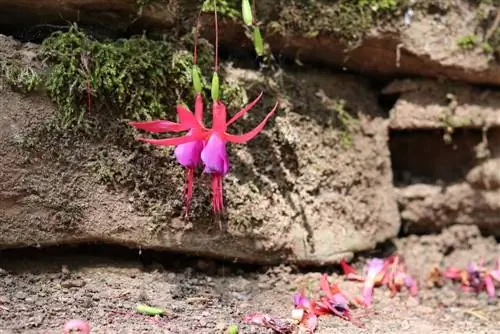
Newly purchased fuchsias or home-grown young plants may only be planted in the garden in May after the Ice Saints. Planting should be done by mid-July at the latest, so that the fuchsia has enough time to grow. Only use well-developed plants, they achieve the necessary winter hardiness more quickly and reliably.
- Find a suitable, sunny location.
- Dig the soil well.
- If necessary, remove foreign, still active roots.
- Dig a hole and insert the plant.
- Fill the space with soil, leaving a watering trough.
- Water the plant well.
- Keep the soil moist at all times, but not too wet.
- Fill up the hollow in autumn.
- Plant a ground cover or cover the soil with a layer of bark mulch.
Tip:
The planting hole should be 10 cm deeper than usual. This means the rootstock is better protected from cold and drying out. Fertilize your fuchsia with potash magnesia, also known as patent potash, when planting, this supports winter hardiness.
Repotting
If you keep hardy fuchsias in pots, they must be repotted into a larger pot once a year at the beginning of the growing season. To do this, use a high-quality container plant soil from the store or mix the plant soil yourself. Use one part each of garden soil, compost and quartz sand. The fuchsia pot must have a drainage hole that is protected from clogging with a shard.
Pouring
In a sunny place, the soil dries out more quickly and needs to be watered diligently, especially in summer. However, always water as needed, as fuchsias do not like waterlogging. The current weather plays a significant role. In summer, during the flowering period, daily watering is usually necessary. Only water in the morning and, if not otherwise possible, also in the evening. Never water in the midday heat! On dry days, you can rinse the fuchsia with lime-free water in the morning and evening.
Note:
If the soil is still sufficiently moist in the morning, you should not water the fuchsia that day.
Fertilize
Fuchsias that grow permanently outdoors must not be fertilized too much. Over-fertilization would have more serious consequences than insufficient fertilization.
- too strong growth
- less flower production
- reduced winter hardiness
How to properly fertilize your winter-hardy outdoor varieties:
- first fertilization in spring
- Subsequent fertilization at the beginning of flowering
- Always combine fertilization with watering
- commercially available complete fertilizer with trace elements is sufficient
- Long-term fertilizer is also recommended
- Depending on the soil composition, fertilization with lime is advisable
Note:
You can fertilize hardy fuchsias in the pot every two weeks during the flowering period with a commercially available fertilizer for flowering plants.
pruning
The hardy fuchsias bloom on annual shoots. If fuchsias are not pruned regularly, they would become bald over time. They are cut back in spring as soon as new growth has begun. Use clean and sharp secateurs to cut off at least a third of the fuchsia, if possible not into the old wood.
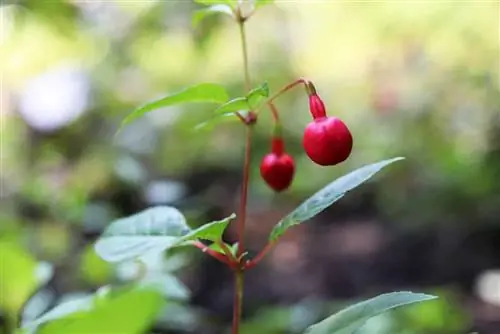
However, with many hardy fuchsia varieties, the above-ground parts usually freeze off in winter. For these varieties, leave at least 2/3 of the above-ground plant parts standing in the fall, even if they freeze later. They are good winter protection for the fuchsia roots. In spring, scratch the old shoots with a sharp knife to see if they have died. If so, cut them down to the ground. The fuchsia then sprouts new shoots directly from the roots. You should regularly remove wilted flowers.
Propagate
Even hardy fuchsias can easily be propagated from cuttings. A good time is August, on the one hand it is still warm and on the other hand the cuttings still have enough time to root. With the step by step instructions you can propagate it effortlessly.
- Clean and disinfect a pair of sharp secateurs.
- Select several soft or slightly woody shoot tips.
- Cut off the shoots below the third pair of leaves.
- Carefully remove the bottom pair of leaves.
- Fill small pots about 12 cm in diameter with potting soil.
- Plant two to three cuttings in each pot.
- Water the cuttings well.
- Then cover it with a transparent cap.
- After two weeks you can air the plants occasionally.
- Once the cuttings have grown after about 6 weeks, you should transplant them into normal soil.
Tip:
Dip the ends of the cuttings in a mineral rooting powder before planting. The trace elements it contains stimulate root growth.
The young plants may bestill too weak to spend the first winter outdoors. First overwinter them in a suitable winter quarters. Planting out should only take place next year, when the plants are stronger and already have woody shoots.
Winter protection
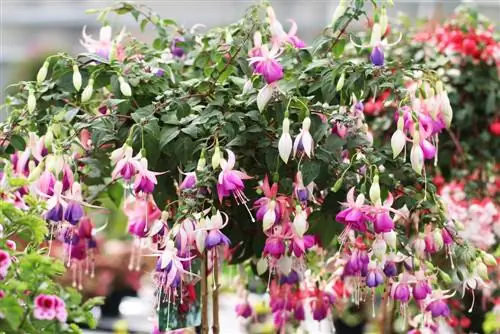
Even hardy fuchsias need winter protection in harsh winters. The shallow root ball in particular is sensitive to cold. This is how you can successfully overwinter your fuchsias:
- only plant strong fuchsias
- young fuchsias are not sufficiently hardy
- new fuchsias must be planted early in the summer so that they can grow well
- Cover the root area with bark mulch or a 30-40 cm layer of leaves
- Ground cover plants in the root area are also good winter protection
- Stop fertilizing as early as August so that no more immature shoots grow
- Winter protection is no longer required until around April
Note:
You must never cover fuchsias with foil as the air can no longer circulate underneath. There is a risk that your fuchsias will rot.
Overwintering potted plants
Hardy fuchsias planted in pots can tolerate light frosts down to -3 degrees. They should stay outside as long as possible, but will eventually need to move to winter quarters. The following applies:
- darkened place is necessary
- frost-free with temperatures of 10-15 degrees
- cut back slightly beforehand
- remove wilted flowers and yellowed leaves
- water only a little
- do not fertilize
Diseases
Damp weather can promote fuchsia rust. The reddish-brown fungal coating on the underside of the leaves spreads rapidly in good conditions. Act immediately with a commercial fungicide. Good ventilation prevents this disease. When planting, make sure that your hardy fuchsias are not too close to other plants.
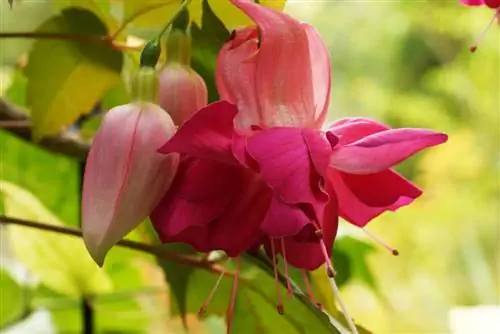
A white coating on leaves, buds and flowers appears if the fuchsia is suffering from powdery mildew. Cut off all affected parts of the plant. Disinfect the cutting tool to avoid further infections. A mixture of water and milk (9:1) is said to effectively combat the fungus. Spray the fuchsia with it and repeat the treatment if the infestation is severe.
Excreta from whiteflies and aphids are food for sooty mold fungus. If you fight these causes, the sooty mold will also disappear.
Note:
Severely infested fuchsias that can no longer be saved must be disposed of with household waste. They don't belong in the compost heap.
Pests
Extreme drought or damp weather can often lead to pest infestation. The most common pests are:
- Aphids
- Fuchsia gall mites
- Red Spiders
- Weevils
- Thrips
- Bugs
- Whiteflies
A suitable location and planting that is not too close can help preventatively. Once they are there, the sooner the infestation is discovered, the more effectively they can be combated.
- Check fuchsias regularly for pest infestation
- don't forget the undersides of the leaves and the inside of the flowers
- A powerful shower of water from the hose drives away some pests
- biological pest control is preferable, e.g. B. Nematodes against weevil larvae
- Use spray mixtures made from natural ingredients
- chemical agents are poison for the environment and are only the last alternative

